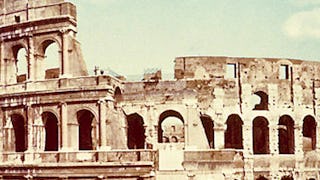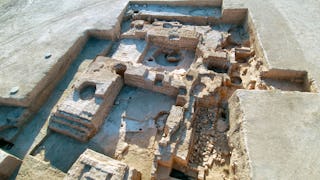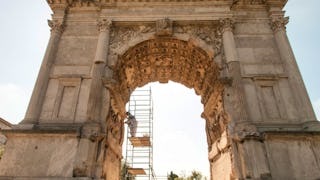The course presents the topographical lay-out of the most relevant part of the city. Research developed on the Palatine since the end of last century by the team of Sapienza Classical Archaeologists opened a new phase in the urban archaeological investigation and in the scientific debate about the relation between archaeological features and literary tradition as well as the “correct use“ of both kind of evidence, key issues of wide archaeological and historical significance.

Enjoy unlimited growth with a year of Coursera Plus for $199 (regularly $399). Save now.

Paesaggi di Roma Antica. Archeologia e storia del Palatino.

Instructor: Paolo Carafa
4,790 already enrolled
Included with
(146 reviews)
Skills you'll gain
Details to know

Add to your LinkedIn profile
8 assignments
See how employees at top companies are mastering in-demand skills

There are 8 modules in this course
Studiare una città antica, così come medioevale o moderna, significa definire storie locali basate sulla ricostruzione dei paesaggi e dei loro mutamenti attraverso i secoli. Dato lo stato frammentario della documentazione archeologica, è necessario creare immagini nuove che restituiscano l’aspetto fisico del paesaggio urbano per riportarlo in vita. Non è sufficiente analizzare i molti elementi antichi ancora visibili nella città di oggi. Per definire gli elementi che componevano il paesaggio urbano, devono essere riallacciati i nessi e le relazioni che esistevano tra oggetti e architetture, visibili e non visibili, che sono stati spezzati dal tempo. Il paesaggio e il suo contenuto sono elementi vitali e rilevanti del patrimonio culturale di ogni nazione. Il corso introdurrà gli studenti al modo con il quale, durante gli ultimi venti anni, abbiamo condotto lo studio del passato delle nostre città, a partire dal caso più complesso nel mondo mediterraneo: il cuore dell’Italia e dell’Impero Romano. E’ bene ricordare che la conoscenza significa conservazione e protezione dei resti materiali e della memoria culturale. “Paesaggi di Roma Antica. Archeologia e storia del Palatino” presenta ad un vasto pubblico l’assetto topografico della parte più importante della città (secondo gli storici antichi Roma sarebbe stata fondata sul Palatino). Le ricerche, condotte sul Palatino dal team di archeologi classici della Sapienza dalla fine del ‘900, hanno aperto una nuova fase nello sviluppo dell’archeologia urbana a Roma e nel dibattito sulla possibile relazione tra dati archeologici e tradizione letteraria e sul “buon uso” di entrambe le classi di dati. Si tratta di un argomento chiave, di grande significato archeologico e storico. Gli studenti del corso saranno introdotti a metodi e procedure sviluppate e impiegato con successo dalla Scuola di Archeologia Classica della Sapienza per la raccolta, analisi, integrazione e interpretazione di contesti complessi e multi stratificati, inclusi attuali strumenti e metodi innovativi, basati su un’approfondita conoscenza archeologica e storica ma anche su tecnologie informatiche.
What's included
4 videos1 assignment
What's included
4 videos1 assignment
What's included
4 videos1 assignment
What's included
4 videos1 assignment
What's included
4 videos1 assignment
What's included
4 videos1 assignment
What's included
4 videos1 assignment
What's included
4 videos1 assignment
Instructor

Offered by
Explore more from History
- Status: Preview
Sapienza University of Rome
 Status: Preview
Status: PreviewUniversity of Arizona
 Status: Preview
Status: PreviewSapienza University of Rome
 Status: Preview
Status: PreviewYeshiva University
Why people choose Coursera for their career




Learner reviews
146 reviews
- 5 stars
82.87%
- 4 stars
13.01%
- 3 stars
2.05%
- 2 stars
2.05%
- 1 star
0%
Showing 3 of 146
Reviewed on Mar 30, 2018
Corso molto interessante e coinvolgente! Spero che, a breve, ne verranno fatti altri :-)
Reviewed on Mar 28, 2020
Un corso bellissimo!Davvero interessante e ben spiegato. Un racconto affascinante della trasformazione del cuore di Roma dalle sue origini fino alla caduta dell'Impero
Reviewed on Jul 16, 2021
Corso eccellente in una cornice suggestiva cosi' evocativa di più' di mille anni di storia cosi' ben narrati dal prof. Carafa, auspico una maggiore presenza della Sapienza su questa piattaforma.

Open new doors with Coursera Plus
Unlimited access to 10,000+ world-class courses, hands-on projects, and job-ready certificate programs - all included in your subscription
Advance your career with an online degree
Earn a degree from world-class universities - 100% online
Join over 3,400 global companies that choose Coursera for Business
Upskill your employees to excel in the digital economy
Frequently asked questions
To access the course materials, assignments and to earn a Certificate, you will need to purchase the Certificate experience when you enroll in a course. You can try a Free Trial instead, or apply for Financial Aid. The course may offer 'Full Course, No Certificate' instead. This option lets you see all course materials, submit required assessments, and get a final grade. This also means that you will not be able to purchase a Certificate experience.
When you purchase a Certificate you get access to all course materials, including graded assignments. Upon completing the course, your electronic Certificate will be added to your Accomplishments page - from there, you can print your Certificate or add it to your LinkedIn profile.
Yes. In select learning programs, you can apply for financial aid or a scholarship if you can’t afford the enrollment fee. If fin aid or scholarship is available for your learning program selection, you’ll find a link to apply on the description page.
More questions
Financial aid available,


